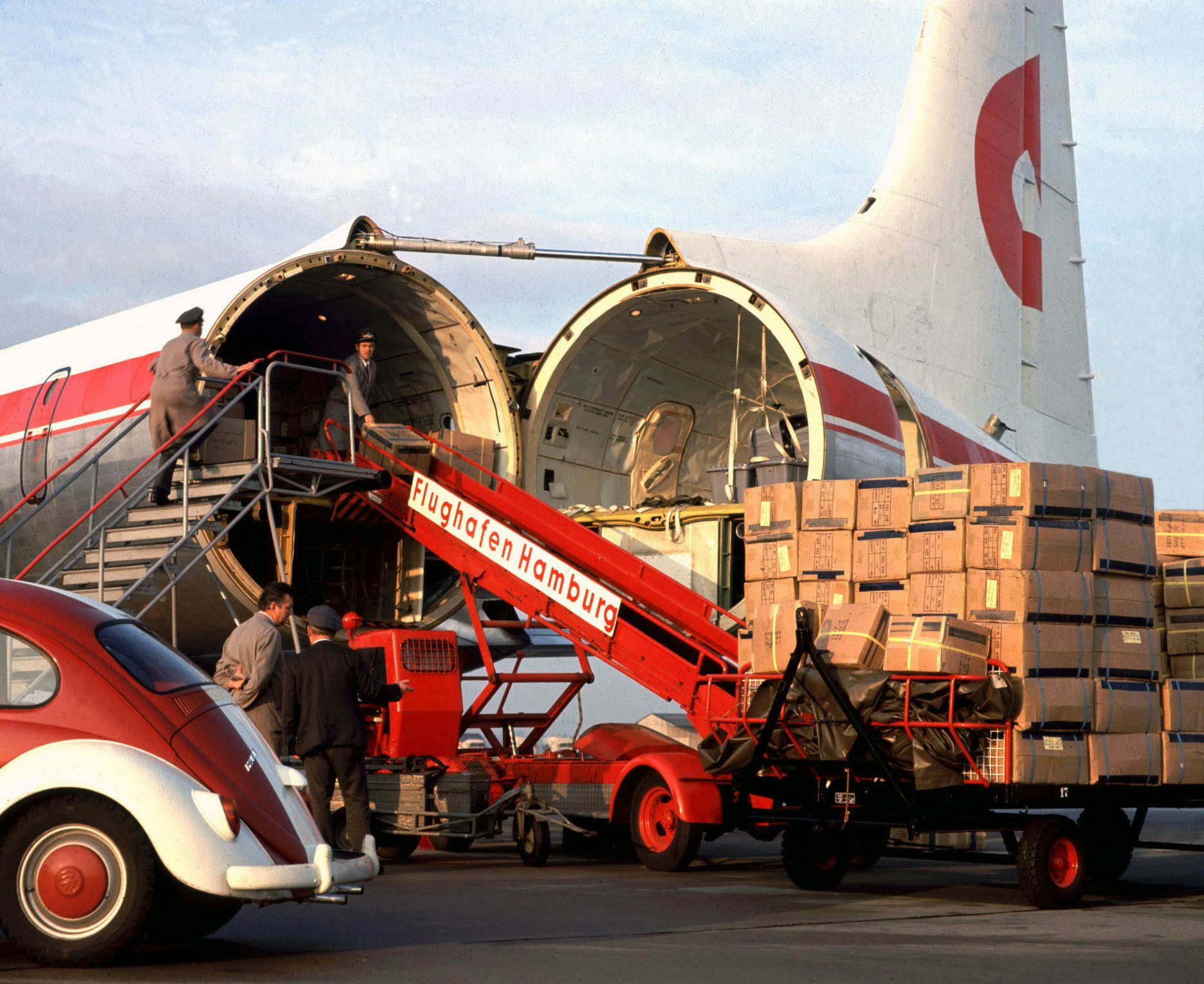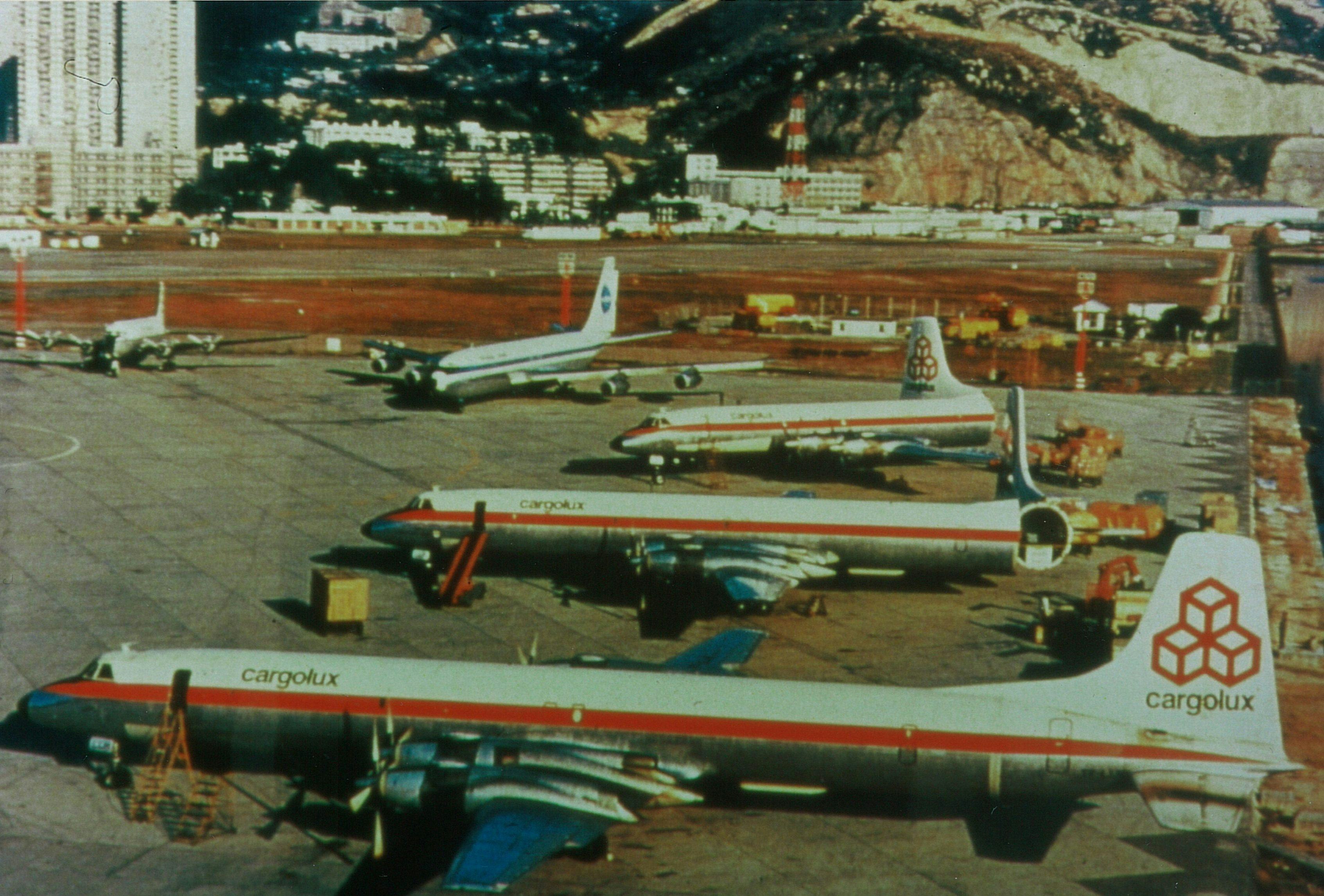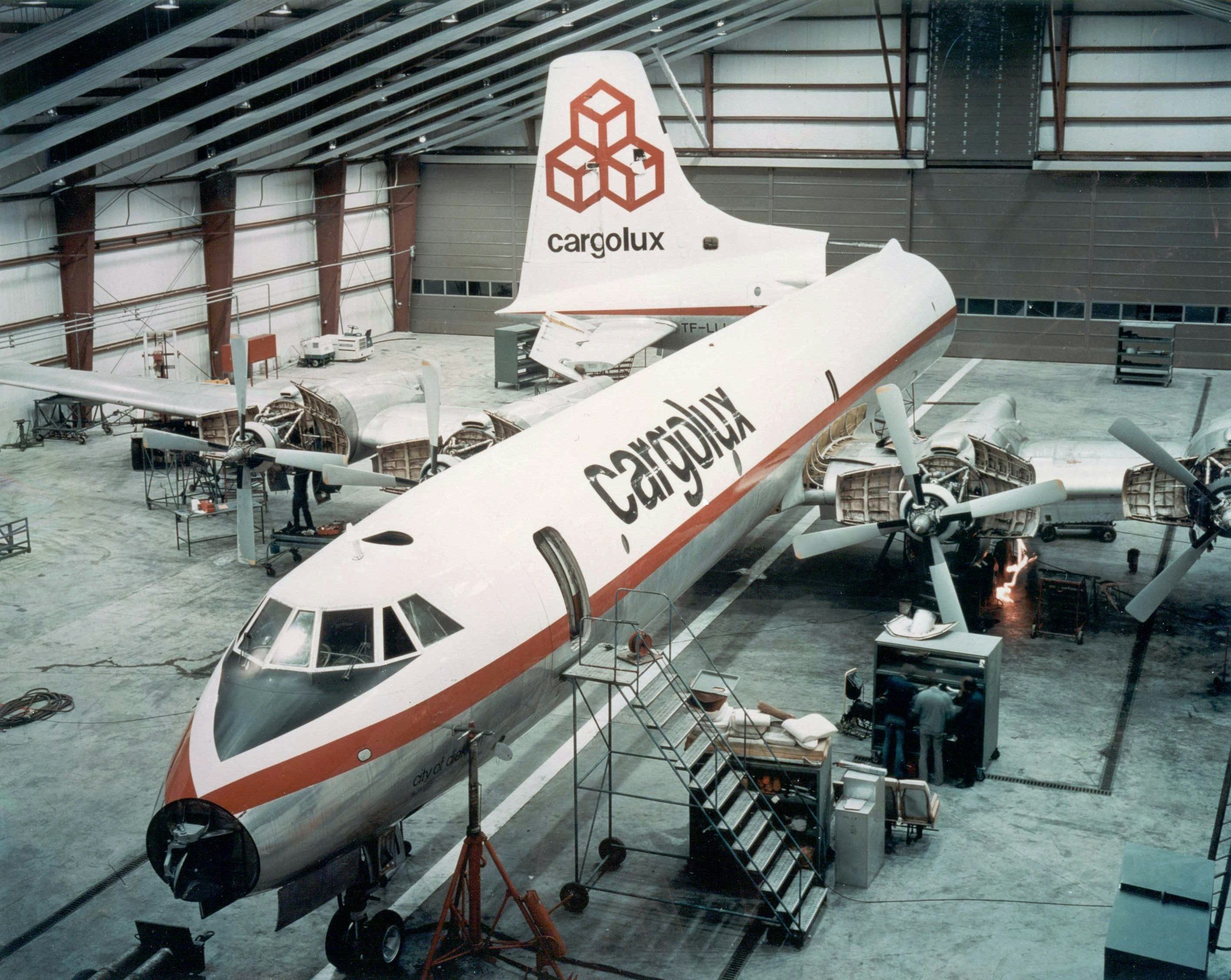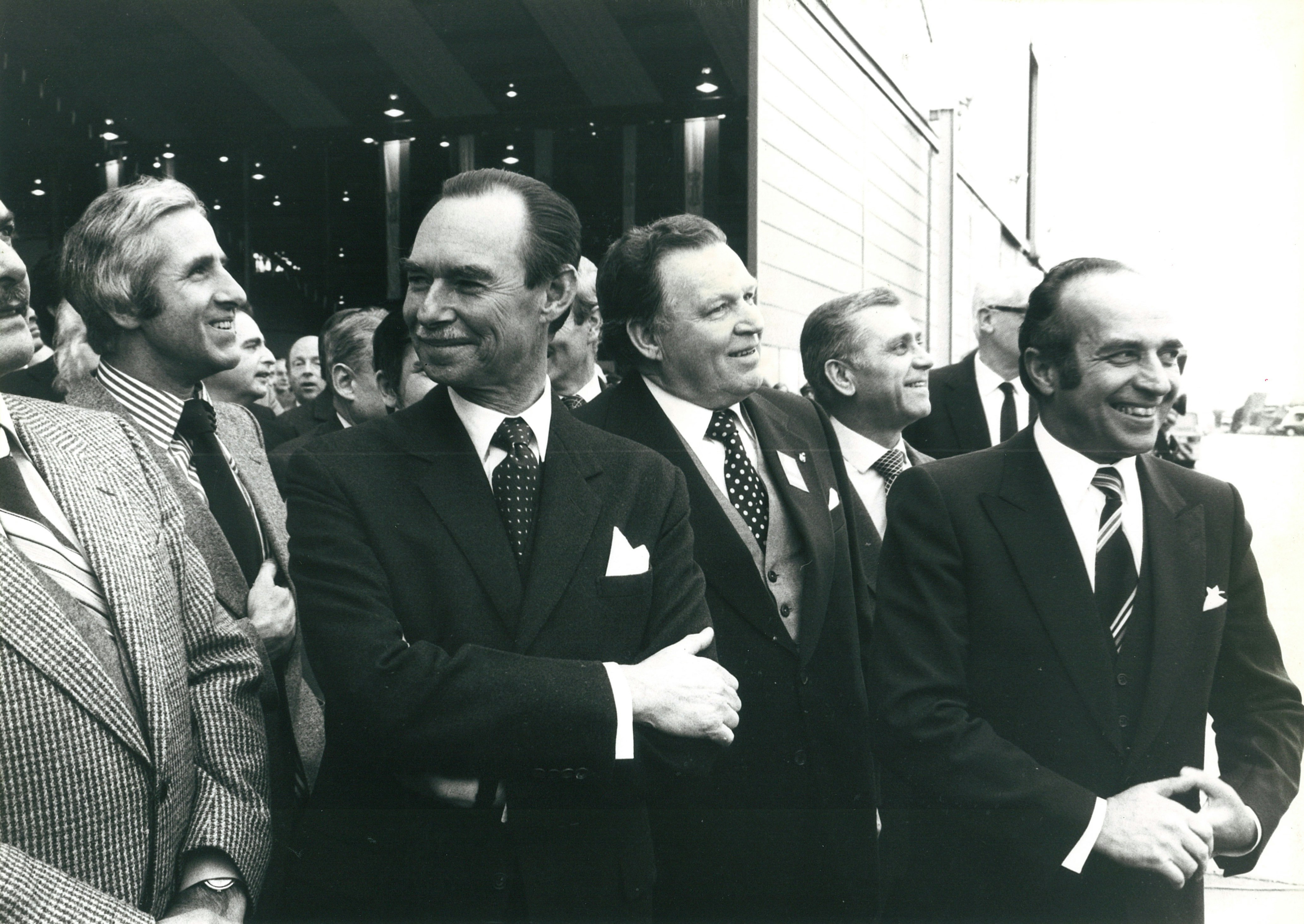1970 - 1979
The early years
The first decade in the long Cargolux history was one of expansion, bold decisions, and dedicated people who worked together in order to get the company off the ground and into the air.
The dawn of a success story
The first decade in the long Cargolux history was one of expansion, bold decisions, and dedicated people who worked together in order to get the company off the ground and into the air.
Our history starts back in 1969, in the early days of air cargo, when opportunities in aviation were plentiful. The jet age was in its infancy and domestic airlines were juggling the early requirements of an increasingly popular commercial aviation industry for both passenger and commodities. Loftleiðir Icelandic was operating out of the Grand-Duchy and the Luxembourgish government had expressed interest in collaborating with Loftleiðir on several new economic ventures; a first-class hotel, a tour operator, and a cargo airline.
At the time, Johannes Eirnarsson, one of Cargolux’s founding fathers was working as Director of Corporate Planning for Loftleiðir. His mission was to either lease or sell the company’s Canadair CL-44s as the Icelandic national carrier entered the jet age. The aircraft, flown by Loftleiðir in a passenger configuration, were originally conceived as freighters with the distinctive advantage of a swing tail opening. This feature enabled the loading of long and large pieces, making it a perfect contender for freighter operations.
-
-
![CL-44 TF-LLJ]()
TF-LLJ, Cargolux's first CL-44
-
![CL 44 gt loading01]()
-
-
-
![CL 44 two ac]()
Gallery
Three determined partners
After an aborted attempt at selling one of the CL-44s to a group of pilots in Malmo, Sweden, due to a lack of funding; the story made headlines in the country, and Johannes Einarsson was contacted by Christer Salén of Salén Shipping company. The Swedish-based shipper had been studying air cargo and was interested in setting up a split operation. Indeed, Salén’s original idea was to fly Scandinavian tourists to and from Spain at the weekend, then convert the aircraft to cargo configuration and use it to transport fresh fruit and vegetables back to Sweden during the week.
Johannes Einarsson quickly dismissed the idea, claiming it was impossible to convert the aircraft fast enough for the initiative to be viable. Instead, he offered an interesting alternative; setting up a cargo airline. The Grand-Duchy government's interest coupled with the country’s prime location in the heart of Europe convinced Salén and Loftleiðir that Luxembourg would be ideally suited for the company’s headquarter. Johannes Einarsson then made Christer Salén a partnership offer, whereby both parties would acquire 50 percent interest in Loftleiðir CL-44 aircraft. The agreement was sealed with a handshake and the joint venture Saloft was born.
The next step was to go over to Luxembourg and discuss the details and feasibility of establishing an all-cargo airline. The Luxembourg government, Luxair, Salén, and Loftleiðir entered discussions and while these talks were ongoing, Loftleiðir and Salén decided to convert the first CL-44 aircraft back to its initial cargo configuration and start operating ad-hoc and charter flights from Luxembourg. In November 1969, the first flight on behalf of Saloft was operated from Luxembourg to Sao Tome with relief goods for Caritas.
-
![CL-44 relief goods]()
-
![CL-44 Hamburgclean]()
-
![CL-44 take-off]()
CL-44 take-off
-
![CL 44 fleetinhongkong]()
-
![CL 44 gt loadtubes03]()
-
-
![CL-44 LoadingHistpress3]()
-
![CL-44 City of Luxembourg]()
City of Luxembourg
Gallery
Cargolux takes off
After months of discussions, negotiations between the 3 parties broke through and Cargolux was founded on March 4th, 1970. With one aircraft leased from Saloft, a Canadair CL-44 D42, registered TF-LLJ, and a handful of enthusiastic employees, the airline was set up in an office in downtown Luxembourg, on the first floor of a building on Avenue de la Liberté. The Air Operator Certificate was delivered on May 10th, 1970 and wasting no time, the first flight Cargolux flight took off the next day; a ferry flight from Stockholm, Arlanda, to New York, JFK, to pick up iceberg lettuce and strawberries.
Means were slim and hopes were high for the single crew and four ground staff that comprised the Cargolux team. The office boasted a single room in the middle of which was a full-size ping-pong table. The multi-purpose table served as a desk for the staff but was quickly converted to its original use once the aircraft left on long charter trips.
-
![CL 44 strawberries]()
Loading strawberries onto a CL-44
-
-
![CL 44 snow]()
-
Loading an ambulance onto a CL-44
-
Loading a car onto a CL-44
Gallery
An operational puzzle
Those first years were also a challenge for the operations department. Cargolux did not have any traffic rights at the time, so each flight required meticulous preparation and planning. The operations team had to request the traffic rights, overflying permits, and landing rights for each flight based on the flight plan. The flight also often left to the Far East with no return load booked. Once the aircraft was on route, the sales team would phone all their contacts in order to find cargo – if not as return load, then from another destination. This practice cost the sales team many busy and sleepless nights, but business took off and the company grew.
On August 11th, 1970, Cargolux acquired a second CL-44, a CL-44J, TF-LLG, the stretched version, to cater for the budding business. Unfortunately, it was lost in Dacca, then East Pakistan, on December 2nd, 1970, while operating an International Red Cross relief airlift for the victims of recent flooding. The accident claimed the lives of the four crewmembers and 4 people on the ground. This tragic episode came as a shock to all employees working for the company at the time and the mood grew sullen for some time but the Cargolux spirit lived on. The staff stuck together and powered through this first difficult event to make the company even stronger and more successful.
The aircraft was replaced by a standard CL-44 and over the course of the next two years, 3 more stretched CL-44s joined the growing fleet. By the end of 1972, Cargolux was operating a total of five CL-44s, three of which were the stretched versions. Cargolux was the only airline to operate this stretched version which offers 18% more volume than the standard versions. As the airline steadily developed, the headquarters downtown were abandoned and Cargolux moved to Luxembourg airport, closer to its core operation.
Starting as a charter operation on an ad-hoc basis, Cargolux flew a number of relief flights in the early days which slowly developed into regular services to Hong Kong. The airline then started to operate regular flights to Nigeria on behalf of Panalpina which also evolved into regular business. As trade grew, and the aviation industry quickly evolved, speed became a determining factor in global commerce, and competition within the cargo sector began to warrant the use of jet aircraft.
-
![CL-44 maintenance]()
-
-
-
![People - crew 70s]()
Crew members from the 70s
Gallery
Entering the jet age
In October 1973, Cargolux entered the jet age when Cargolux took delivery of a DC-8-61CF freighter, TF-BCV. The first DC-8 flight went from Luxembourg to Hong Kong loaded with 34 tons of machinery. In spring 1974, the DC-8-61CF was replaced by a DC-8-55F, N806SW, and Cargolux subsequently developed a fleet of DC-8-63 aircraft. In September 1975, the company concluded a long-term lease/purchase agreement for a DC-8-63F (ex. Flying Tigers) aircraft that became the first Cargolux aircraft under Luxembourg registration – LX-BCV.
With the fleet steadily growing and business developing rapidly, the question of maintenance was becoming increasingly pressing. When operating Loftleiðir’s second-hand CL-44s, the maintenance was done at the Icelandic company’s facilities in New York. Once Cargolux had taken over the aircraft, it was decided to shift the maintenance from New York to Luxembourg to allow for a more reliable service. On January 1st, 1974, Cargolux integrated Loftleiðir Icelandic’s Maintenance & Engineering Department in Luxembourg. The equipment was moved overseas and a mere month later, Cargolux signed a contract for the construction of a new hangar and head office complex at Luxembourg Airport, which was inaugurated on April 28th, 1975.
The next few years proved to be a solid foundation for the company’s expanding business and the building block of a successful and sustainable cargo airline. From the beginning, the Cargolux business model defined the company as the “freight forwarders’ airline”, a B2B model that has stayed with the company ever since and set Cargolux apart from its combination carrier competitors. As business grew, so did the company’s ambitions and soon, the question of the interrogation about fleet and capacity was raised.
-
![DC-8 Top01]()
-
![DC-8 nosepilot]()
-
-
![Maintenance Construction old hangar]()
Cargolux's first maintenance hangar under construction
Gallery
Cargolux goes jumbo
In December 1977, Cargolux took a giant leap forward and decided to purchase a jumbo jet; a Boeing 747-200 freighter. After contemplating several options, including a DC10 freighter, Cargolux settled on the 747, a bold decision considering the huge increase in capacity this aircraft represented compared to either the CL-44 or the DC-8. On 30 January 1979, Cargolux took delivery of its first B747 freighter, LX-DCV, named City of Luxembourg, firmly underlining its commitment to become a major all-cargo airline. At the time, Cargolux was the only all-cargo airline in Europe to operate such an aircraft. The sales team got to work, and the gamble proved successful; so much so that another 747 was ordered in autumn of the same year and the CL-44s were gradually phased out.
As these old aircraft were set to leave the Cargolux fleet, the company was also looking at options to diversify its business and expand its activities. The South American continent seemed like an attractive market at the time and so, on July 26th , 1977, Cargolux founded Aero Uruguay together with some local interests who had the necessary rights to start the company. The airline was based in Montevideo and operated regular services to Miami and New York via Manaus and Sao Paulo. Flights were also operated to Luxembourg via Sao Paulo and Sal Island and the airline offered regional services to Santiago. The fleet initially consisted of CL-44 aircraft which was then replaced first by a Boeing 707 and then by a DC8-63F. Cargolux was responsible for the sales side but unfortunately the venture was not very successful and Cargolux ceased its collaboration in Uruguay in the early 80s.
Back in Luxembourg, however, business was bustling despite certain clouds on the horizon due to high fuel prices and interest rates. The acquisition of a jumbo jet marked a turning point for Cargolux, a reflection of the airline's growth and a testament to its sustainability. Over the years, Cargolux and Boeing forged a solid relationship as the Luxembourg-based carrier emerged as one of the iconic 747 operators. The aircraft rapidly became one of Cargolux’s strongest selling point and remained so even through troubled times. The company was about to go through some its toughest times, but nothing ever wavered the passion of the people, the ambition of the airline, or the intimate conviction that Cargolux is and will remain the best all-cargo carrier in the industry.
-
Signature for the first order of a 747-200
-
-
![747-200 - Grand Duke]()
Inauguration 747 200 Grand Duke
-
![747 200 first landing]()
-
Gallery































